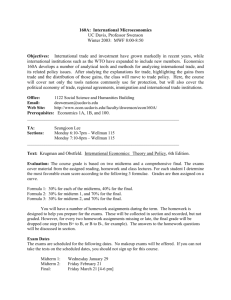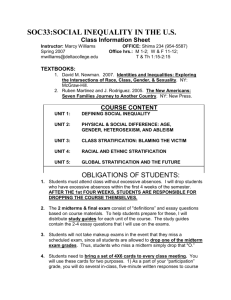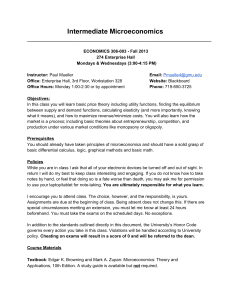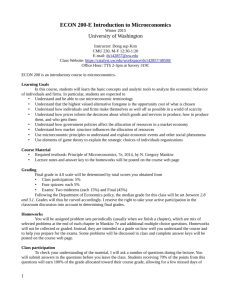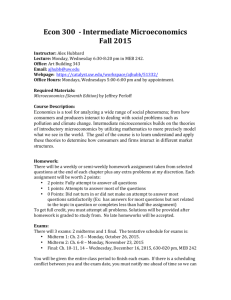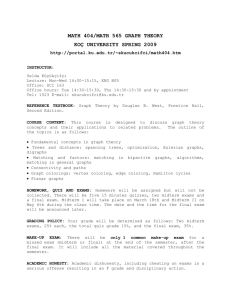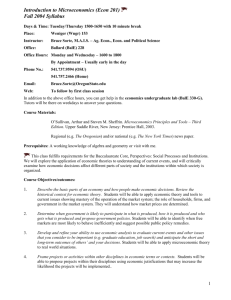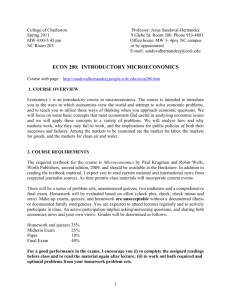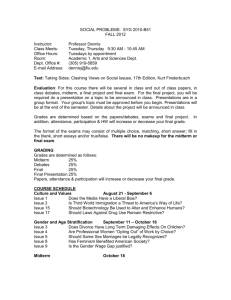Introductory Microeconomics
advertisement
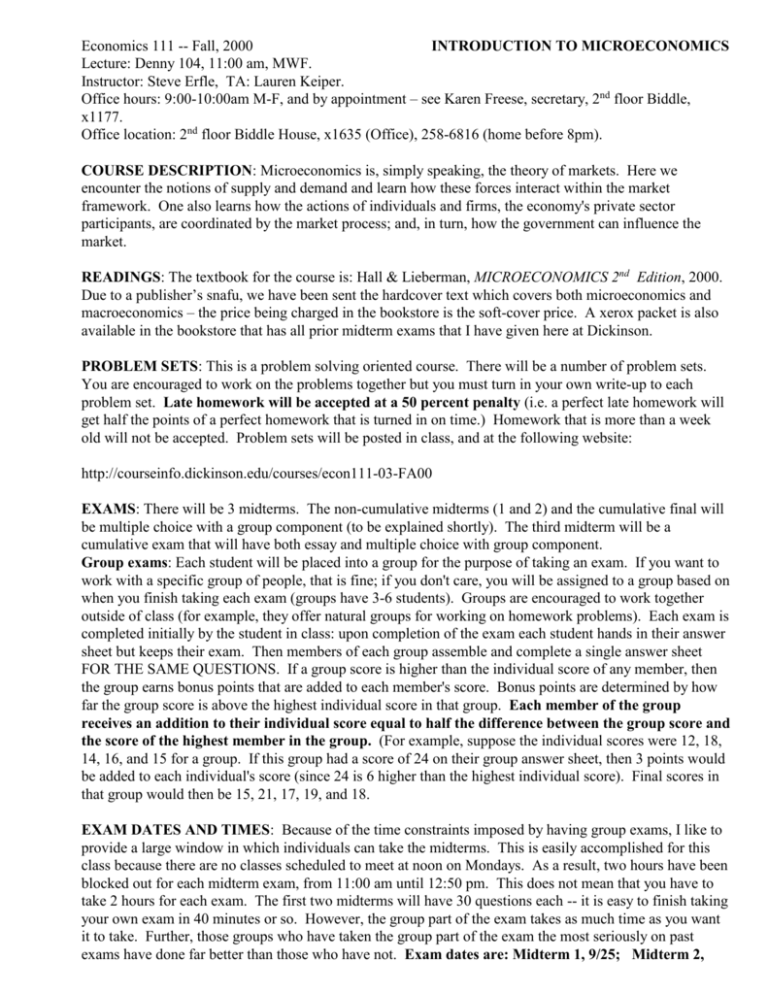
Economics 111 -- Fall, 2000 INTRODUCTION TO MICROECONOMICS Lecture: Denny 104, 11:00 am, MWF. Instructor: Steve Erfle, TA: Lauren Keiper. Office hours: 9:00-10:00am M-F, and by appointment – see Karen Freese, secretary, 2nd floor Biddle, x1177. Office location: 2nd floor Biddle House, x1635 (Office), 258-6816 (home before 8pm). COURSE DESCRIPTION: Microeconomics is, simply speaking, the theory of markets. Here we encounter the notions of supply and demand and learn how these forces interact within the market framework. One also learns how the actions of individuals and firms, the economy's private sector participants, are coordinated by the market process; and, in turn, how the government can influence the market. READINGS: The textbook for the course is: Hall & Lieberman, MICROECONOMICS 2nd Edition, 2000. Due to a publisher’s snafu, we have been sent the hardcover text which covers both microeconomics and macroeconomics – the price being charged in the bookstore is the soft-cover price. A xerox packet is also available in the bookstore that has all prior midterm exams that I have given here at Dickinson. PROBLEM SETS: This is a problem solving oriented course. There will be a number of problem sets. You are encouraged to work on the problems together but you must turn in your own write-up to each problem set. Late homework will be accepted at a 50 percent penalty (i.e. a perfect late homework will get half the points of a perfect homework that is turned in on time.) Homework that is more than a week old will not be accepted. Problem sets will be posted in class, and at the following website: http://courseinfo.dickinson.edu/courses/econ111-03-FA00 EXAMS: There will be 3 midterms. The non-cumulative midterms (1 and 2) and the cumulative final will be multiple choice with a group component (to be explained shortly). The third midterm will be a cumulative exam that will have both essay and multiple choice with group component. Group exams: Each student will be placed into a group for the purpose of taking an exam. If you want to work with a specific group of people, that is fine; if you don't care, you will be assigned to a group based on when you finish taking each exam (groups have 3-6 students). Groups are encouraged to work together outside of class (for example, they offer natural groups for working on homework problems). Each exam is completed initially by the student in class: upon completion of the exam each student hands in their answer sheet but keeps their exam. Then members of each group assemble and complete a single answer sheet FOR THE SAME QUESTIONS. If a group score is higher than the individual score of any member, then the group earns bonus points that are added to each member's score. Bonus points are determined by how far the group score is above the highest individual score in that group. Each member of the group receives an addition to their individual score equal to half the difference between the group score and the score of the highest member in the group. (For example, suppose the individual scores were 12, 18, 14, 16, and 15 for a group. If this group had a score of 24 on their group answer sheet, then 3 points would be added to each individual's score (since 24 is 6 higher than the highest individual score). Final scores in that group would then be 15, 21, 17, 19, and 18. EXAM DATES AND TIMES: Because of the time constraints imposed by having group exams, I like to provide a large window in which individuals can take the midterms. This is easily accomplished for this class because there are no classes scheduled to meet at noon on Mondays. As a result, two hours have been blocked out for each midterm exam, from 11:00 am until 12:50 pm. This does not mean that you have to take 2 hours for each exam. The first two midterms will have 30 questions each -- it is easy to finish taking your own exam in 40 minutes or so. However, the group part of the exam takes as much time as you want it to take. Further, those groups who have taken the group part of the exam the most seriously on past exams have done far better than those who have not. Exam dates are: Midterm 1, 9/25; Midterm 2, 10/30; Midterm 3, 12/1; Final, 12/14, 2-5pm. Each exam will be given in the HUB Social Hall. If you foresee problems with this time frame, please see me so that we can work something out. GRADING CRITERION: Each exam is graded on a curved (as opposed to an absolute) scale. You will receive a numerical score on each exam and an indication of the approximate letter grade attached to that score. Aside from midterm 3 you have some choice: midterm 3 is worth 25 percent of your grade. There are four remaining scores: midterm 1, midterm 2, the final and the cumulative homework. I drop the lowest of these four scores and weight each of the remaining three by 25 percent. This means that you have some choice: You must take midterm 3 but you do not have to do the homework, or you don't have to take one of midterms 1 and 2 or the final to do well in the course. However, realize that the best way to do well on the exams is to do the homework. MAKEUP POLICY: My makeup policy for exams is very simple: if you miss an exam due to a documented serious illness or family emergency, then you are entitled to take a makeup exam. Makeup exams are not given for any other reason. Makeups are, at the professor’s discretion, ORAL EXAMS covering the same material as the missed exam. ASKING QUESTIONS: I wish to explicitly encourage classroom participation. If you have a question about something that I have (or have not) said, then it is likely that others around you are also confused. The lectures may seem to move slower if many questions are asked but I believe that much more learning occurs in such an interactive environment. LECTURE POLICY: I encourage you to attend my class but will not keep a formal roll sheet. Much of this course examines the notion of choice -- I therefore leave it up to you. PROBLEM SOLVING SESSIONS: I will provide weekly problem solving sessions that should help you with the problem sets and also help you review for exams. I plan to hold these each Friday at noon in Denny 104, starting September 8th. These sessions are NOT required, but are offered as a way of reducing the anxiety you may feel about the course, particularly concerning the homework and exams. Additionally, the grader for the course, Lauren Keiper, will hold weekly problem sessions at times TBA. CHEATING POLICY: I would prefer to not have to worry about cheating, but, unfortunately, that is something that happens on campus. As you may know, faculty opinions differ regarding how cheating should be dealt with. I have in the past, and will continue in the future, to pursue any cheating that occurs in my course. If you draw a blank on an exam, it is much better to simply fail that exam than to fail the course and face the possibility that further penalties will be imposed by the Dean of Educational Services and Student Affairs. COURSE OUTLINE I. INTRODUCTION, HISTORICAL CONTEXT, AND ANALYTICAL CONSTRUCTS Ch. 1-4. IIa. CONSUMER THEORY (underpinnings of demand) Chapter 5 and its appendix. IIb. PRODUCER THEORY (underpinnings of supply) Ch 6-7. III. PRODUCT MARKETS (putting together supply and demand) Ch 8-10. IV. FACTOR MARKETS (looking at the market for inputs) Ch 11-13. Va. EFFICIENCY AND THE ROLE OF GOVERNMENT (what do we do when markets fails?) Ch. 14-15. Vb. INTERNATIONAL TRADE (how we interact with the world at large) Ch. 16. A NOTE ABOUT TOPIC COVERAGE: We will not cover all of the topics listed above, but will cover sections I – III, and Vb for sure. The exact coverage of the other sections will be determined by how quickly or slowly we cover the other parts of the course. Microeconomics is based, in large part, on marginal analysis; once you learn the basic ideas involved with marginal analysis, the rest is simply reapplying this idea to new situations.
